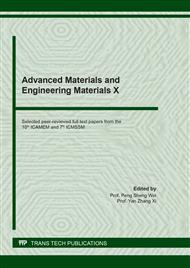p.243
p.250
p.255
p.260
p.268
p.277
p.282
p.287
p.293
Distributions of Stress and Interlaminar Shear Stress in Laminates under Normal Load
Abstract:
The normal stress of each layer of the laminate composite material will undergo complex changes after normal compression, and shear stress will also appear between the layers. In order to explore the distribution laws of normal stress and shear stress, this paper uses Hooke's law and the equilibrium condition of force to carry out mathematical derivation, the analytical formulas for normal stress and shear stress are obtained, and their respective maximum values are given. Studies have shown that the maximum normal stress occurs at the center of the laminate, and its value is proportional to the external load, and is also closely related to the length, width, thickness, elastic modulus of the cementing agent, elastic modulus and Poisson’s ratio of the laminate; The maximum shear stress occurs at the four corners of the laminate, and its value is proportional to the external load and the shear modulus of the cementing agent, inversely proportional to the thickness of the cementing agent layer, and its value is also closely related to the length, width, elastic modulus and Poisson's ratio of the laminate. The analytical formulas for normal stress and interlayer shear stress is helpful to deepen the understanding of the internal force distribution law of laminated plates, and the maximum value calculation formula can greatly facilitate the calculation of strength.
Info:
Periodical:
Pages:
268-273
Citation:
Online since:
November 2021
Authors:
Price:
Сopyright:
© 2021 Trans Tech Publications Ltd. All Rights Reserved
Share:
Citation:


